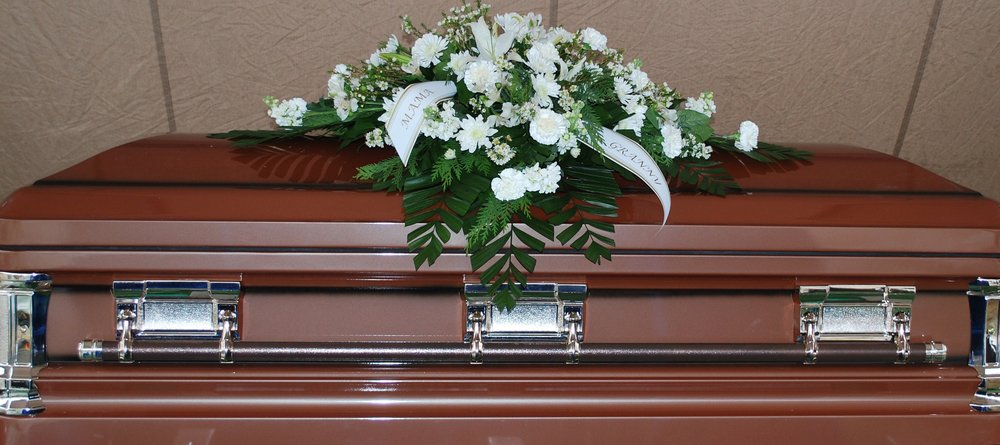Updated
When someone dies from a work injury in California, there are special benefits available to those that depended on the deceased worker for financial support. These benefits are based on the relationship to the deceased worker and the amount of financial support the deceased worker gave them.
Death benefits are:
- paid to individuals that qualify as “total” or “partial” dependents,
- paid based on the relationship to the deceased and amount of support they got, and
- requested in a specific way within a particular time frame.
For those who lost the person who financially supported them, and the death was caused by a work injury, this article will explain:
- 1. What are California workers’ compensation death benefits?
- 2. Who gets the California death benefits?
- 3. How do you file a claim for death benefits?
- 4. How much are death benefits?
- 5. How are death benefits paid?
- 6. What about temporary and permanent disability payments?
- 7. How to pursue death benefits

When someone dies from a work injury in California, there are special benefits available to those that depended on the deceased worker for financial support.
1. What are California workers’ compensation death benefits?
Death benefits include burial expenses and cash benefits to the dependents that the deceased injured worker supported.1
2. Who gets the California death benefits?
The death benefits go to an employee’s “total dependents” and “partial dependents”.
A deceased employee’s spouse who earns $30,000 or less in the twelve months before the death and children under 18 are considered to be total dependents.2
Partial dependents are determined based on the facts and circumstances of the case.3
All “dependency” determinations are based on facts at the time of injury, not the time of death.4
Example: Nathan is severely injured. He cannot work. He dies one year later from his injury. Prior to his injury, he supported his brother James, who was in college. After the injury, James has to take out a loan and work more to support himself.
The determination of whether James was a dependent is based on the support he got from Nathan prior to the injury.
For any person to be considered a dependent, he or she must be a member of the household or a relative in the immediate family of the deceased employee or their spouse.5 Relatives that can be considered dependents are:
- children (adopted or step)
- spouse
- siblings
- parents
- grandparents
- aunts and uncles
- nephews and nieces
- in-laws
To be considered a household member, you must have lived with the deceased worker.
Example: Cory lives with his girlfriend, Joanne, and her daughter Bridget. Cory is killed in an accident at work. Even though Joanne and Bridget are not related to Cory, they may be able to claim the death benefit because they are part of Cory’s household.
Example: Assume Cory also has an adult child, Michael, from a prior marriage. Although Michael does not live with Cory, he is related. Michael could be a partial dependent if he received support from Cory.
Example: Cory’s ex-wife Michelle is not part of his household, nor is she currently related to Cory. She would not qualify for the death benefit as either a total or partial dependent.
A judge can alter death benefits for multiple dependents based on need and in a just and equitable manner.6
If there are no dependents, the payment goes to the California Department of Industrial Relations.7
3. How do you file a claim for death benefits?
Death benefits require a special Application. This workers comp form should be filed with the California Workers’ Compensation Appeals Board in your area within one year of the date of death.8

To obtain death benefits, a person dependent on the deceased worker needs to understand how to file a California workers’ compensation claim and settle a workers comp claim with the insurance company.
4. How much are death benefits?
California workers’ compensation death benefits include:
- up to $10,000 for burial expenses; and
- up to $320,000 for the injured worker’s dependents
The amount of the death benefits depends on the number of people claiming that they were supported by the deceased worker.
If there is one total dependent, they will receive $250,000.9
If there is one total dependent and one or more partial dependents, the total dependents will receive $250,000.10 The partial dependents will get up to $25,000.11
If there are two total dependents, there can’t be any partial dependents. The two total dependents will split $290,000.12
Three or more total dependents will split $320,000.13
The benefits are divided equally.14
One or more partial dependent will receive up to $250,000.15 This is split in proportion to their support level.16
4.1 Calculating death benefits
Calculating death benefits is a complicated procedure. It depends on the number of total dependents and number of partial dependents.
Dependency is determined by how much the person relied on the deceased worker to support his or her standard of living.17
4.1.1 Total dependency
“A total dependent relies on the deceased for all of his or her support.”18 It does not mean that the dependent is unable to work, only that he or she is totally reliant on the deceased employee.19 Small inconsequential amount of income from another source does not invalidate the total dependency claim.20
Example: Joe dies due to a work accident. His wife, Beverly, worked part-time and earned $25,000 a year. His adult son, Matt, lives in an apartment in another city. He is not working and is going to school. Matt relies on Joe for all of his support.
Beverly and Matt are both total dependents–Beverly because she earns less than $30,000 a year, and Matt because all of his support came from Joe.
4.1.2 Partial dependency
Partial dependents must perform an additional calculation. It is eight times the amount of annual support.21
Being a partial dependent means that they have a means of support other than the deceased employee.22
The amount of yearly support is the actual dollar amount that comes from the deceased employee to support the partial dependent.23
If the partial dependent is a husband or wife, the amount the deceased employee contributed to their joint expenses would count. However, income just used by the deceased spouse would not.24
Example: April is killed in an automobile accident while working. She lives by herself, but she helps to support four people. She has four potential partial dependents:
- Gwen, her sister
- Eve, her adult daughter
- Scott, her adult son
- Monique, her friend
April gave Gwen $500 a month to help with her rent. Her total yearly contribution to Gwen was $6,000.
April made Eve’s car payment and paid her auto insurance. This totaled $4,500 a year.
April paid for Scott’s acting classes at $5,000 a year.
Monique has been unable to find a job, so April gave her $300 a month to help with expenses. The yearly total was $3,600.
Gwen, Eve, and Scott qualify as partial dependents. They were all related to April. Even though
April gave Monique money, Monique was neither related to April, nor did she live with her. Monique is not a dependent.
Since partial dependency is eight times the amount of support:
- Gwen receives $48,000
- Eve receives $36,000
- Scott receives $40,000
According to California’s workers’ compensation death benefit laws, if there are one or more partial dependents, the partial dependents will receive up to $250,000 split in proportion to their support level. The total of $124,000 for Gwen, Eve, and Scott is less than the maximum of $250,000 for three or more dependents. They will each receive the amounts above.
The money will be paid out every two weeks, split between each of the dependents based on their proportionate share. The amount paid out each week is based on April’s temporary disability rate. This amounts to two-thirds of her weekly earnings.
4.2 Additional payments to minor children
If there are any children of the deceased employee under 18 after the death benefits are paid out, those benefits will continue until that child reaches 18.25
They are paid at the temporary disability rate.
Example: Jason dies in a work accident. He has two total dependents–his wife, Jody, and three-year-old child, Brooke. They receive a death benefit of $290,000. Jason’s temporary disability rate was $800 a week.
Jody and Brooke will receive $800 a week until the total reaches $290,000. This will take nearly seven years. At the end of this period, Brooke will be ten years old.
Brooke can continue to receive $800 a week until she turns 18 years old. This is an additional $291,000.
5. How are death benefits paid?
Death benefits are paid at the same rate as the deceased employee’s temporary disability rate, but not less than $224.26 The temporary disability benefit rate is two-thirds of the employee’s average weekly earnings.27
6. What about temporary and permanent disability payments?
Neither temporary disability benefits nor permanent disability payments are made after the injured worker’s death.28 Any payments that were made for this have no effect on the death benefit.29
7. How to pursue death benefits
The insurance company may conduct a detailed investigation of the claim for death benefits including an examination of the cause of the injury and death, and they will conduct depositions on those claiming to be dependents.
To obtain death benefits, a person dependent on the deceased worker needs to understand how to file a California workers’ compensation claim and settle a workers comp claim with the insurance company. One can appeal a workers comp decision denying death benefits.
Call us for help…
Was your loved one killed in a work-related injury? Contact one of our personal injury attorneys for help. (For cases in Nevada, please visit our page on death benefits in Las Vegas Nevada workers compensation cases.)
LEGAL REFERENCES:
- Cal. Lab. Code § 4701
- Cal. Lab. Code § 3501
- Cal. Lab. Code § 3502
- Id.
- Cal. Lab. Code § 3503
- Cal. Lab. Code § 4704
- Cal. Lab. Code § 4706.5
- Cal. Lab. Code § 5406
- Cal. Lab. Code § 4702(a)(3)
- Cal. Lab. Code § 4702(a)(2)
- Cal. Lab. Code § 4703
- Cal. Lab. Code § 4702(a)(1)
- Cal. Lab. Code § 4702(a)(5)
- Cal. Lab. Code § 4703
- Cal. Lab. Code § 4702(a)(4)
- Cal. Lab. Code § 4703
- Chevron U.S.A., Inc. v. Workers’ Comp. Appeals Bd. (1999) 19 Cal. 4th 1182, 1189
- Id.
- Munoz v. Workers’ Comp. Appeals Bd. (1971) 19 Cal. App. 3d 144, 147
- Id.
- Cal. Lab. Code § 4702(b)(4)(B)
- Chevron U.S.A., Inc., at p. 1189
- Id., at p. 1190
- Id., at p. 1192
- Cal. Lab. Code § 4703.5
- Cal. Lab. Code § 4702(b)
- Cal. Lab. Code § 4653
- Cal. Lab. Code § 4700
- Cal. Lab. Code § 4702(c)
